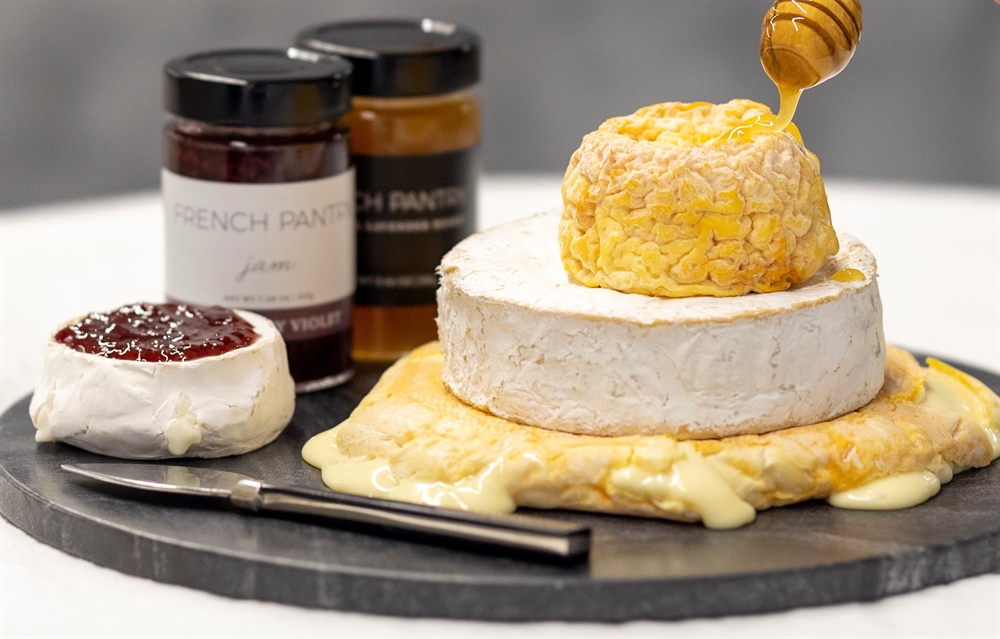
Say CHEESE!
Like Bread, Cheese is Sacred!
There are many golden rules for buying, packaging, storing, and keeping the temperature for cheese correct. With the craving to experiment with tastes and cooking at home, At bon COOK, we have found people prefer small bites of information that are easily read and forever remembered. This simple principal list on cheese explains the top five principles to preserve the life and flavor of your precious cheese.
Principal 1 – Buy in Small Quantities:
The French have it right when it comes to buying cheese! When choosing, focus on small quantities. To fully enjoy cheese, the French indulge themselves by devouring their cheeses quickly and often visit their Cheesemonger or market intending to express interest in seasonal cheeses. I love the philosophy of the French: large quantities are for caterers; small amounts are for the home.
Principal 2 – Respect the Temperature:
Your best ally for preservation is your refrigerator. A cold temperature makes it possible to lengthen the lifespan of your cheeses so much so that it slows down the microorganisms responsible for degradation. Once bought, transport your cheese in an insulated bag or cooler (summer months) and place it in the refrigerator. Cheese is stored best in the refrigerator drawer with less cold and more humidity. To maintain the taste and texture do the best not to allow the temperature of the cheese to drop much because this action can alter the taste and texture of the cheese. You can freeze low humidity cheeses after securely wrapping, like how you would freeze and wrap a fresh pie dough. Keep in mind that fresh and soft cheeses are more humid and less resistant to freezing, although they can be frozen and perfectly cooked once thawed. Frozen cheeses need to defrost in the refrigerator, not at room temperature. And therefore, it may take several hours.
Principal 3 – Avoid Contact with Air:
Now let’s talk about the storing principle of cheeses. A well-wrapped cheese is a well-preserved cheese! Wrap properly to protect the cheese and avoid direct contact with air. If not properly packaged, the cheese may reform a hard crust or mold because air causes your cheese to oxidize. A solution for this is reusable beeswax wrapping roll or food wrapping sheets even when stored in an airtight container.
These sheets allow the humidity control around the cheese and still enable the oxygen to circulate.
Principal 4 – Save the Date:
Plan your use around the date on your cheese packaging. A good plan is to buy diverse types of cheese with varying end dates, and you will always have a nice cheese to taste or serve. Expiration dates vary and need attention when buying cheese. As with any food, you should check the cheeses you purchase or follow the advice of your cheesemaker. Cheese packaging contains a sell-by, a best-by, or a use-by date. Always check for cheese with the farther date in the cheese category to ensure you are buying the freshest cheese available.
Principal 5 – Know-How to Create the Best Taste for Enjoying:
Lastly, remove cheeses from the refrigerator one-half hour to two hours before serving. Like a fine wine, cheese needs a minute too, which is why removing cheeses from the refrigerator before a meal will allow all the aromas to awaken for best tasting! Those who find themselves stuck when deciding on what cheeses to serve to make an exciting tasting choose wisely to meet every palate. Think one of each – Stinky, Sharp, Hard, Mild, Creamy. Taste is as individual as your cheese and your guests. Following the five principles shared, I am confident you will enjoy hearing your friends say, “pass the cheese, please!
Cindy Juncaj,
CEO and Partner
bon COOK





